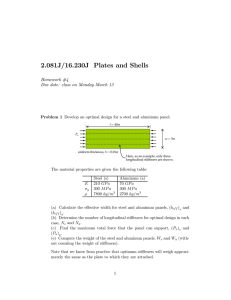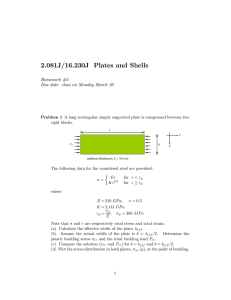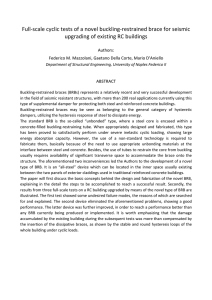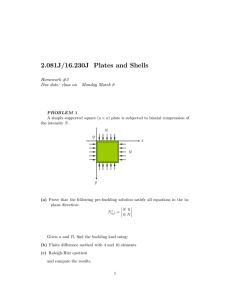Finite Element Analysis of Cold–Formed Steel Structural Members
advertisement
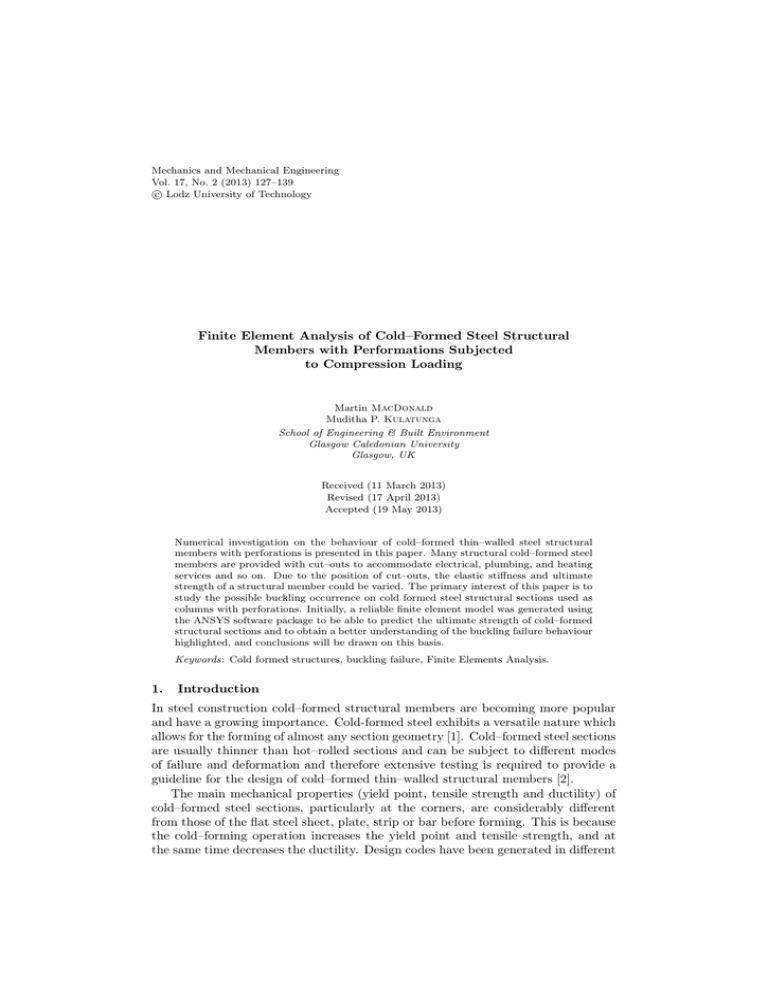
Mechanics and Mechanical Engineering Vol. 17, No. 2 (2013) 127–139 c Lodz University of Technology ⃝ Finite Element Analysis of Cold–Formed Steel Structural Members with Performations Subjected to Compression Loading Martin MacDonald Muditha P. Kulatunga School of Engineering & Built Environment Glasgow Caledonian University Glasgow, UK Received (11 March 2013) Revised (17 April 2013) Accepted (19 May 2013) Numerical investigation on the behaviour of cold–formed thin–walled steel structural members with perforations is presented in this paper. Many structural cold–formed steel members are provided with cut–outs to accommodate electrical, plumbing, and heating services and so on. Due to the position of cut–outs, the elastic stiffness and ultimate strength of a structural member could be varied. The primary interest of this paper is to study the possible buckling occurrence on cold formed steel structural sections used as columns with perforations. Initially, a reliable finite element model was generated using the ANSYS software package to be able to predict the ultimate strength of cold–formed structural sections and to obtain a better understanding of the buckling failure behaviour highlighted, and conclusions will be drawn on this basis. Keywords: Cold formed structures, buckling failure, Finite Elements Analysis. 1. Introduction In steel construction cold–formed structural members are becoming more popular and have a growing importance. Cold-formed steel exhibits a versatile nature which allows for the forming of almost any section geometry [1]. Cold–formed steel sections are usually thinner than hot–rolled sections and can be subject to different modes of failure and deformation and therefore extensive testing is required to provide a guideline for the design of cold–formed thin–walled structural members [2]. The main mechanical properties (yield point, tensile strength and ductility) of cold–formed steel sections, particularly at the corners, are considerably different from those of the flat steel sheet, plate, strip or bar before forming. This is because the cold–forming operation increases the yield point and tensile strength, and at the same time decreases the ductility. Design codes have been generated in different MacDonald, M, Kulatunga, M.P. 128 countries [3], [4], [5], and [6] amongst many others for cold-formed steel structures subjected to various loading scenarios which can cause buckling, bending and web crippling or a combination. Many structural cold–formed steel members are provided with perforations of different shapesto accommodate electrical, plumbing, and heating services and so on as illustrated in Figure 1. The position of suchperforations can affectthe elastic stiffness and ultimate strength of a structural member[7]. 1.1. Effects of perforations In practice, perforations are either pre–punched or punched on–site on the cold– formed sections, to pass through conduits, utility ducts, etc [8]. The presence of perforations in a structural member has often created a number of problems and drawbacks and complicates the design process. In general the effect of perforations made specifically for fasteners such as bolts, screws, etc. on the overall strength of a structure may be neglected as holes are filled with material. However, any other openings/perforations generated and not filled with replacement material creates a reduced cross sectional area and cross sectional properties and this should be taken into account in any analysis. The effect of perforations on the structure is examined by testing and analysis. Leading design rules for cold–formed steel members with perforations are largely based on empirical formulae which have been developed by numerous researchers in the past, and are limited to certain perforation sizes, shapes, orientations, and positions. These limitations have created a number of problems and can decrease the reliability of cold–formed steel sections in the building construction industry [9]. The results of the investigations of cold–formed steel structural members with perforations, previously conducted by various researchers, have found that a concentrated load that may potentially cause deformation of the structure is applied over perforations. However, it has been identified that due to the shape of the perforations and the thickness of the sections and for other practical reasons, reinforcement of these perforations in thin–walled members is not possible. 2. Buckling behaviour of cold–formed structural members Unlike heavy hot–rolled steel sections, cold–formed thin–walled sections tend to buckle locally at stress levels lower than the yield strength of the material when they are subjected to various loading conditions. However, these members do not fail at these stress levels and continue to carry further loads. This phenomenon is called post-buckling behaviour. In thin-walled cold–formed steel structures, elastic bucking and load deformation response are closely related. The influence of perforations may promote unique buckling modes and can encourage collapse mechanisms at the ultimate state [10]. During the last few decades, the research work on thin–walled cold–formed steel members with perforation has showed failures occurred due to high stress concentrations around perforations, especially in the sharp corner areas, irrespective oftheir shapes and configurations [11]. There are different buckling modes as illustrated in Figure 2: Local [12], Distortional [12], Euler, Torsional–Flexural and Lateral–Torsional [13]. Finite Element Analysis of Cold–Formed Steel ... 129 Figure 1 Perforations for fasteners A Section A-A (a) Locally buckled plain channel [ 15]. (b) Distortional buckling behaviour of compressed structural members [15]. (c) Nonlinear locally buckled and Flexural torsional buckling mode [ 15]. Figure 2 Different buckling modes 130 MacDonald, M, Kulatunga, M.P. It is well known that cold–formed thin–walled members under compression load exhibit local and global post buckling behaviour[14]. Overall column strength is greatly dependenton the interaction effect of local and overall column buckling. It is recognised that cold formed steel compression members may locally buckle before the applied load reaches the overall collapse load of the column. The influence of local buckling on column strength depends on the following factors: the slenderness ratio of the column, the shape of the cross section, influence of cold work, the type of steel used and its mechanical properties, the type of governing overall column buckling, effect of imperfection, effect of welding, interaction between plane components, effect of perforations, effect of residual stress etc. For short columns, local buckling occurs first leading to large deflections. Local buckling involves deformation of the component plate elements of the section, with the plate junctions remaining straight and occurs as plate buckling of individual slender elements in a cross-section as shown in Figure 2(a). In general, local buckling near the perforation controls the elastic buckling stress of the plates. Distortional buckling is characterised by rotation of the flange at the flange/web junction in members with edge stiffened elements and occurs only for open crosssections where the compressed flanges buckle inward or outward along the length of a member as shown in Figure 2(b). This is the form of a ”semi–local” buckling mode which can generally arise at somewhat longer wavelengths. The distortional buckling mode has been found to govern the strength of sections with intermediately stiffened elements [16], [17]. The elastically determined post–buckling behaviour is generally stable, but in–plane deformations can encourage substantial membrane stresses and rapidly produce yield and failure in the stiffeners [18], [19]. For long columns under compression load, Euler buckling is more likely to occur before any other instability failure and occurs by bending about the web[20]. When aslender member is subjected to an axial force, failure in the member takes place due to torsion or bending rather than direct compression of the material. Further, if the compression member is not supported in the lateral direction the member will fail due to lateral buckling of the compression flange [21].This phenomenon occurs when the flexural load increases to a critical limit. In wide–flange sections, if the compression flange buckles laterally, the cross section will also twist in torsion, resulting in a failure mode which represents lateral–torsional buckling. The lateral torsional buckling strength of a section could be increased by using a bracing system. In general, bracing systems could be divided into two categories namely, lateral bracing and torsional bracing. Cold formed steel structures are made of thin steel sheets and have often mono symmetric or un–symmetric cross sections. Hence their lateral–torsional buckling behaviour is more complicated than that of doubly symmetric hot–rolled beams. Past research on lateral–torsional buckling of steel beams has mainly concentrated on hot–rolled steel beams [22]. The buckling mode is influenced by cross–section geometry, end conditions, loading and material. Also, introducing perforations to structures has a significant effect on the critical buckling load and the buckling mode [23], [24]. Finite Element Analysis of Cold–Formed Steel ... 3. 131 Numerical investigation Finite Element Analysis (FEA) is an accurate and flexible technique to forecast the performance of a structure, mechanism or process under different loading conditions. A general finite element procedure with a particular emphasis on analysing thinwalled members using ANSYS finite element software package is presented here. FEA is now commonly used early in a design process to try out new concepts and optimise before any physical prototypes are made and tested.The three main stages in an FEA are: generation of the model, solving the model, and saving and reviewing the results. A commonly employed methodology to generate a finite element model in ANSYS is the direct generation of the finite element model, creating a solid model within ANSYS or importing a solid model created in a separate CAD system. Direct generation is employed when the model is fairly simple and provides much more control over the geometry and numbering of nodes and elements. However, for relatively large or complicated models this approach becomes less flexible. The ANSYS program has a large library of element types. These elements are mainly categorised based on the features embedded into the element type. The common types of elements for structural analysis are categorised as link, plane, beam, solid and shell elements. In general, cold–formed thin–walled members such as channel sections, encompass relatively thin webs, flanges and lips, and are subjected to loading through flanges. Further, these members can have large width–to–thickness ratios. Shell elements are often used to model thin–walled structures and provide more accurate results with a reasonable solution time compared to volume elements. SHELL181 is one of the shell elements in the ANSYS element library along with many other shell elements such as SHELL43, SHELL93, etc [25] (Figure 3(a)).SHELL181 has features which can represent thin–walled structures effectively such as suitability for analysing thin to moderately–thick shell structures, suited for linear, large rotation, and/or large strain nonlinear applications. Load can be appliedusing a load bearing plate. SOLID45(Figure 3(b)) is one of the most suitable element types among other elements such as SOLID46, SOLID65, and SOLID70 etc. The element has plasticity, creep, swelling, stress stiffening, large deflection, and large strain capabilities. Finite Element Analysis of a structure is mainly carried out to investigate the structural behaviour of the structure due to various loading conditions. Hence, accurate modelling of the loading is vital. There are several ways of applying the necessary loading to a structure: as displacements, structural forces or pressures onto either geometric entities or a set of nodes in the finite element model if the investigation is a pure structural analysis. Boundary conditions are defined based on supports, connections and contacts. In practice, boundary conditions can change during loading and could affect the final solution. However, these effects are difficult to determine and are often neglected. Boundary conditions are applied by restraining the displacements and/or rotations of a set of selected nodes and are varied according to the structure. Many structures show one or more symmetries with regards to their geometries and loading. The model size is optimised by applying appropriate boundary conditions along the planes of symmetry by identifying symmetric features [25]. MacDonald, M, Kulatunga, M.P. 132 Triangular option (Not recommended) a) SHELL181 geometry Prism option Surface coordinate system Tetrahedral option (Not recommended) b) SOLID45 geometry Symmetry plane Modeled potion c) Two dimensional plate model with symmstry Mapped mesh Free mesh d) Examples of transition free and mapped mesh Figure 3 Element types (a, b),symmetry boundary condition (c), and mesh type (d) [25] Meshing is an integral part of the computer aided engineering simulation process. The accuracy, convergence and speed of the solution depend on the density of the mesh. Furthermore, the time it takes to create and mesh a model is often a significant portion of the time it takes to get results from a CAE solution. Therefore, better and more automated meshing tools give better results. Three basic steps are involved in the meshing process:element attributes, mesh controls, and meshing the model. During the solution process ANSYS program performs a series of statistical operations using a system of simultaneous equations generated from the finite element model and corresponding nodal results are stored. ANSYS provides several types of equation solvers depending on the analysis type. The type of analysis could be static, buckling, transient or modal and must be specified at the beginning of the solution process. The type of analysis depends on the behaviour of the system being examined and the results expected. Structural behaviour could be analysed on the basis of its linear or nonlinear response to external forces. Linear analysis provides a fast solution and usually with less amount of modelling time. However, small displacements and rotations within the linear range of material behaviour will give accurate results. In real circumstances structures exhibit nonlinear behaviour within their actual loading ranges, mainly due to geometric nonlinearities, material nonlinearities and changing status. ANSYS uses the Newton-Raphson method to solve nonlinear problems. This iterative procedure continues until the problem converges. Finite Element Analysis of Cold–Formed Steel ... 4. 133 Analysis of buckling behaviour of stub columns In this design exercise, buckling behaviour of a thin walled cold formed ”C ” section was analysedunder compression loading as detailed in Figure 4. Further, the perforationposition and number of perforations presented in the structure were studied. In the construction industry perforationsare often used for various design purposes and they may be varied with respect to size,shape and position. Perforations are created using a method such as drilling and stamping etc.Areas around perforations are more vulnerable to high stresses leading to possible failure around these regions. Hence, a careful study is required to define the perforation size, position etc. on a structure to keep stresses and strains within acceptable levels.Research is structured intotwo stages:first stage – Finite Element Analysis (FEA) been employed; second stage – FEA results were compared with test results. B=30 mm H=60 mm h=8 mm t=0.75 mm r=2 mm Figure 4 a) p2-wnf perforated on the web near the flanges at 1/4 and 3/4 of the width of the web, b) p2–fnoe perforated on the flanges near the outer edges at 2/3 of the width of the flanges Section Fixed end p2-wfn Displacement p2-fnoe Figure 5 Schematic view of ”C” sections with end support/load bearing plate MacDonald, M, Kulatunga, M.P. 134 Fig. 5 shows schematic views highlighting perforations and position, withone end of the structure fixed and load is applied from the other end with the aid of a load bearing plate. This position represents the pinned–pinnedcondition and gives the option to apply load uniformly along the edge of loading face. Two different types of sections have been used for the FEA analysis and the cross–section is constant. A circular shape perforation is used throughout the analysis as it is more commonly in steel structures, and the load is applied using a load bearing plate at the same speed rate. a) Define cross-section b) Define area c) Generate mesh Shear centre Centroid of C chanel e) Axis of symmetry d) Load bearing plate Figure 6 Generate section (a, b & c)/symmetry boundary condition (d & e) 4.1. Developing FE models for buckling behaviour The cross section was modelled using key points, lines and arcs. Further, cross– section shape was dragged along a line to generate the section. Perforations were created by subtracting required areas from the section using subtract area command and special attention was paid when selecting the relevant area. The sections, Finite Element Analysis of Cold–Formed Steel ... 135 loading and support reactions were symmetrical about the vertical plane therefore only one–half of the section was modelled. Load was applied through a load bearing plate and the plate was modelled as a solid beam. The section was developed using ANSYS element type SHELL181 as it is well– suited for linear, large rotation, and/or large strain nonlinear applications. Further, it is capable of handling change in thickness accounted for in nonlinear analyses. For the bearing plate ANSYS element type BEAM45 was used. The mapped meshing technique was used to generate a variable density mesh. Fine mesh was employed around perforations and coarse mesh further away from the perforations. Figure 6(c) shows the element mesh generated for p2–wnf model and illustrates different regions of the element mesh. Pinned–pinned boundary condition was applied for all loading cases. One end was restricted for three degree of freedoms to represent the fixed end. Nodes in other end were coupled together to represent the fixed condition of the flange to the load bearing plate. Load was applied as nodal displacements under the load bearing plate. The symmetric boundary conditions shown in Fig. 6(e) were applied at mid section of the member, Y–direction displacement was fixed and the rotations about the X–axis and Z–axis were also fixed. Load bearing plate was modeled as a solid block member the same as attached to the section. As a result, nodes adjacent to bearing plate move with the load bearing plate as it was given displacement to represent compression load. At this point X and Z displacements were restricted, with Y displacement allowed. Load is applied through a load bearing plate which represents the actual loading conditions applied in the experiments. Load bearing plate and the top flange of the section were connected by a pair of contact surfaces where nodes on flange edge represent same loading conditions as in load bearing plate. 5. Comparison Results of the analysis were obtained by using ANSYS general postprocessor /POST1 and time history postprocessor /POST26. These processors are built in the ANSYS software and used for different functions. General postprocessor/POST1 was used to view the results of the analysis and to obtain the various nodal stress and strain values and the deformed shape. History postprocessor/POST26 was used to provide results over the time history and very useful in obtaining the load vs. deformation graphs under load bearing plate and other critical locations. Load was applied in terms of displacement and calculated against the displacement. Fig. 7 shows the failure load plot for 2 specimens tested with comparisons to FEA, tests (from experimental investigations carried out by Rhodes and Schnieder [26]), Eurocode and BS5950. Fig. 8 shows the load vs. displacement curves and Von Misesstress distributionfor the 2 specimens obtained from FEA. The comparisons of FEA, test results and design code predictions showed that BS5950 andEurocodespecifications generally provide conservative strength predictions for ultimate buckling strength. Further, the study showed that, based on Finite Element Analysis and experimental evidence, slender cross–sections are substantially affected by local buckling and high stress areas were seen around perforations. MacDonald, M, Kulatunga, M.P. 136 Table 1 Comparison of buckling failure load Label ø hole Net CSA Characteristical Position of Perforation Failure Load, kN ANSYS Test p2 wnf 2 x 8 mm 87% Web near flangesat 1/4 and 3/4 the width of the web 9.20 8.88 BS 5950 8.60 p2 fnoe 2 x 8 mm 87% Flangersnear outeredges at 2/3 thewidth of the flanges 8.70 9.35 8.60 Eurocode3 7.3 9.6 Figure 7 Comparison of buckling failure load 6. Conclusion Finite element models were developed to simulate buckling failure of cold–formed channel section columns with circular cut–outs under compression. ANSYS finite element package was used for the analysis and nonlinear material behaviour was studied in order to represent the plastic failure in the post–yield region. Results showed that the displacement of the structure under compression varied significantly with the cut–out position. The tests carried out in the experimental investigations Finite Element Analysis of Cold–Formed Steel ... 137 p2-wnf p2-fnoe Figure 8 FEA results (load and displacement) for section p2–wnf& p2-fnoe were capable of validating the buckling behaviour of channel sections as exhibited in the FE models. The design codes predicted loads which weren’t very consistent with the FEA and the test results and require further investigation. There have been limited investigations into buckling behaviour of sections with cut–outs and it is understood that there are still no reliable equations or models capable of predicting the ultimate buckling strength. The next step of this research will be an extensive experimental program which is capable of confirming the FEA observations obtained from this research, and results that can be used for further developing finite element models and to inform analytical investigations and design codes. 138 MacDonald, M, Kulatunga, M.P. References [1] Rhodes, J.: Design of Cold–Formed Steel Members, Elsevier Applied Science, England, ISBN 1 85166 595, 1, 1991. [2] Yu, W. W.: Cold–Formed Steel Design, John Wiley & Sons, Canada, 3rd Edition, ISBN 0-471-34809-0, 2000. [3] ENV 1993-1-3:2006, Eurocode: Design of Steel Structures; Part 1.3: General Rules - Supplementary Rules for Cold Formed Thin Gauge Members and Sheeting, 2009. [4] British Standards Institution, British standards for structural use of steel work in buildings – Part 5: Code of practice for design of cold formed thin gauge sections, BS5950, 1998. [5] American Iron and Steel Institute, Specification for the Design of Cold Formed Steel Structural Members, AISI–S100–07, 2007. [6] AS/NZS4600, Cold–Formed Steel Structures, Standards Australia, Sydney, 2005. [7] Don Allen, P. E.: Innovations in Cold–Formed Steel Framing, Insights, pp. 54–56, 2007. [8] Sivakumaran, K. M.: Web crippling Strength of Thin–Walled Steel Members with Web Opening, Thin–Walled Structures, 8, pp.295–319, 1989. [9] Cristopher, D.M.: Direct strength design of Cold-formed steel members with perforations, The Johns Hopkins University, Department of Civil Engineering, Baltimore, 2009. [10] Cristopher, D. M. and Schafer, B. W.: Elastic buckling of thin plates with holes in compression or bending, Thin–Walled Structures, 47, pp.1597–1607, 2009. [11] Zhenyu, Y. and Rasmussen, K. J. R.: Inelastic local buckling behaviour of perforated plates and sections under compression, Thin–Walled Structures, 61, pp.49–70, 2012. [12] Teng, J. G. and Michael, R.: Buckling of thin metal shells, Spon Press, London, 2004. [13] Schafer, B. W., Peköz, T.: Local and distortional Buckling of Cold–Formed Steel Members with Edge Stiffened Flanges, [online] available at: http://ceeserver.cee.cornell.edu/tp26/TWResearchGroup/tpadd/edgepap-corr.doc [accessed 10 January 2011]. [14] Kwon, Y. B. and Seo, G. H.: Prediction of the flexural strengths of welded H– sections with local buckling, Thin–Walled Structures, 54, pp.126–139, 2012. [15] Young, B.: Local buckling and shift of effective centroid of slender sections, Available through: University of Hong Kong [online] website www.hkisc.org/proceedings/2006421/9 Ben-Young.pdf[accessed 10 January 2011]. [16] Teng, J.G. and Zhao, J. Y.: Distortional buckling of channel beam–columns, Thin–Walled Structures, 41, pp.595–617, 2003. [17] Schafer, B. W. and Peköz, T.: Local and distortional Buckling of Cold–Formed Steel Members with Edge Stiffened Flanges, [online] Available at : http://ceeserver.cee.cornell.edu/tp26/twresearchgroup/tpadd/edgepap-corr.doc [accessed 12 December 2011]. [18] Hancock, G. J.: Design for distortional buckling of flexural members, Thin–Walled Structures, 20:3–12, Elsevier, 1997. [19] Yang, D. and Hancock, G. J.: Developments in design for distortional buckling of thin walled members, ICTWS, University of Loughborough, 2004. Finite Element Analysis of Cold–Formed Steel ... 139 [20] Dos Santos, E. S., Batista, E. M. and Camotim, D.: Experimental investigation concerning lipped channel columns undergoing local–distortional–global buckling mode interaction, Thin–Walled Structures, 54, pp. 19-34, 2012. [21] Barbero, E. and Tomblin, J.: Euler Buckling of Thin-Walled Composite Columns, Thin–Walled Structures, 17, pp. 237-258, 1993. [22] Kankanamge, N. D. and Mahendran, M.: Behaviour and design of cold–formed steel beams subject to lateral–torsional buckling, Thin–Walled Structures, 51, Elsevier Science Ltd, pp. 25–38, 2012. [23] Eurocode resources [online] available at: http://www.eurocode-resources.com/buckling-a16.html [accessed 12 January 2011]. [24] AISI, Distortional buckling of cold–formed steel columns, Research Report rp. 00 – 1, Revision, 2006. [25] ANSYS, Inc, ANSYS Mechanical APDL Structural Analysis Guide: ANSYS Release 13.0, USA, 2010. [26] Rhodes, J. and Schneider, F.D.: Compressional Behaviour of Perforated Elements, 12th International Specialty Conference on Cold–Formed Steel Structures, St. Louis, Missouri, USA, 1994.
